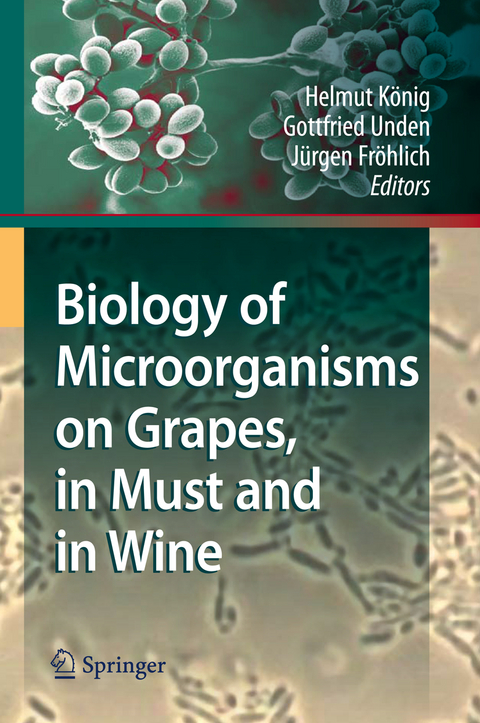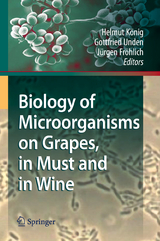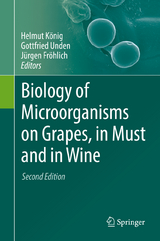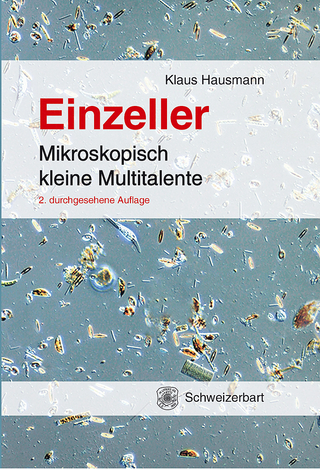Biology of Microorganisms on Grapes, in Must and in Wine
Springer Berlin (Verlag)
978-3-540-85462-3 (ISBN)
Univ.-Prof. Dr. Helmut König. 1971-76 Studium der Chemie und Biologie an der Universität Heidelberg. 1979 Promotion an der Ludwig Maximilians-Universität in München über Archaebakterien. 1986 Habilitation an der Universität Regensburg für das Fach Mikrobiologie. 1987-96 Professor am Institut für Angewandte Mikrobiologie und Mykologie der Universität Ulm. Seit 1996 Leiter des Institutes für Mikrobiologie und Weinforschung der Johannes Gutenberg Universität in Mainz. Forschungsaufenthalte: Department of Health, Empire State Plaza in Albany, (N.Y.), Université Blaise Pascal (Clermont-Ferrand), Jawaharlal. Nehru University (New Delhi), Visiting Foreign Research Fellow (Professor) am Kyoto Institute of Technology; Lehrrauftrag an der Université de Bourgogne (Dijon).Etwa 190 Publikationen und Herausgeber von drei Büchern im Wesentlichen zu den Themen Archaea, Zellwandpolymere, mikrobielle Darmsymbiose, Weinmikrobiologie und Biogasbildner.
Diversity of Microorganisms.- Lactic Acid Bacteria.- Acetic Acid Bacteria.- Yeasts.- Fungi of Grapes.- Phages of Yeast and Bacteria.- Primary and Energy Metabolism.- Sugar Metabolism by Saccharomyces and non-Saccharomyces Yeasts.- Metabolism of Sugars and Organic Acids by Lactic Acid Bacteria from Wine and Must.- Transport of Sugars and Sugar Alcohols by Lactic Acid Bacteria.- Secondary Metabolism.- Amino Acid Metabolisms and Production of Biogenic Amines and Ethyl Carbamate.- Usage and Formation of Sulphur Compounds.- Microbial Formation and Modification of Flavor and Off-Flavor Compounds in Wine.- Pyroglutamic Acid: A Novel Compound in Wines.- Polysaccharide Production by Grapes, Must, and Wine Microorganisms.- Exoenzymes of Wine Microorganisms.- Stimulaling and Inhibitary Growth Factors.- Physical and Chemical Stress Factors in Yeast.- Physical and Chemical Stress Factors in Lactic Acid Bacteria.- Influence of Phenolic Compounds and Tannins on Wine-Related Microorganisms.- Microbial Interactions.- Molecular Biology and Regulation.- Genomics of Oenococcus oeni and Other Lactic Acid Bacteria.- Genome of Saccharomyces cerevisiae and Related Yeasts.- The Genome of Acetic Acid Bacteria.- Systems Biology as a Platform for Wine Yeast Strain Development.- Plasmids from Wine-Related Lactic Acid Bacteria.- Rapid Detection and Identification with Molecular Methods.- Maintenance of Wine-Associated Microorganisms.- DNA Arrays.- Application of Yeast and Bacteria as Starter Cultures.
From the reviews:
"This compilation is outstanding. Forty-nine contributors from eight countries offer recent information on the microbiology of wine production, covering specific topics in both breadth and depth. ... each of the book's 27 chapters stands alone, there is excellent continuity between chapters to give readers a good overview of the subject. ... The text contains detailed tabular information and clear, readily understood figures. ... This is excellent scientific reporting. Summing Up: Highly recommended. Lower-division undergraduates through professionals and practitioners." (G. S. Howell, Choice, Vol. 46 (11), 2009)
| Erscheint lt. Verlag | 15.1.2009 |
|---|---|
| Zusatzinfo | XVIII, 522 p. |
| Verlagsort | Berlin |
| Sprache | englisch |
| Maße | 155 x 235 mm |
| Gewicht | 1063 g |
| Themenwelt | Naturwissenschaften ► Biologie ► Mikrobiologie / Immunologie |
| Schlagworte | Alcoholic fermentation • Amino acid • DNA • Fungi • grape • Malolactic fermentation • Metabolism • microbe • Microbiology • Microorganism • Mikroorganismen • Oenococcus • Oenology • Polysaccharid • Polysaccharide • quality • Regulation • Saccharomyces • Transport • Vinification • Weintrauben • wine |
| ISBN-10 | 3-540-85462-2 / 3540854622 |
| ISBN-13 | 978-3-540-85462-3 / 9783540854623 |
| Zustand | Neuware |
| Informationen gemäß Produktsicherheitsverordnung (GPSR) | |
| Haben Sie eine Frage zum Produkt? |
aus dem Bereich





